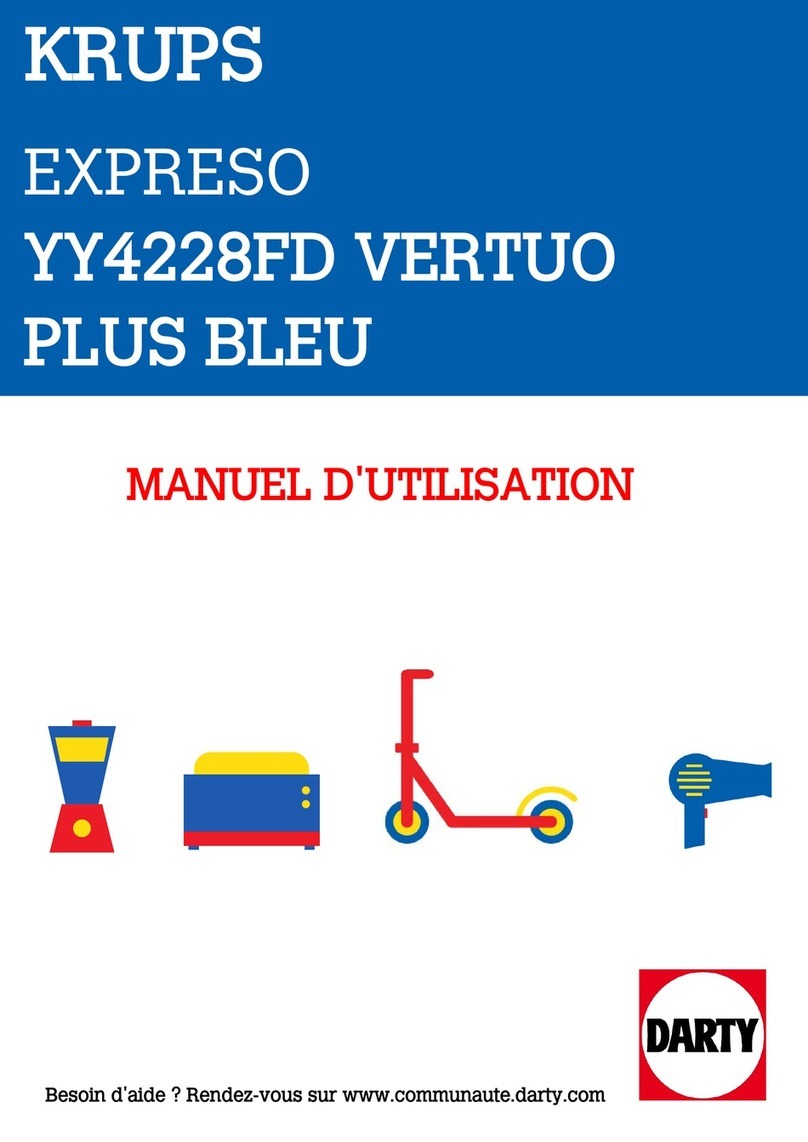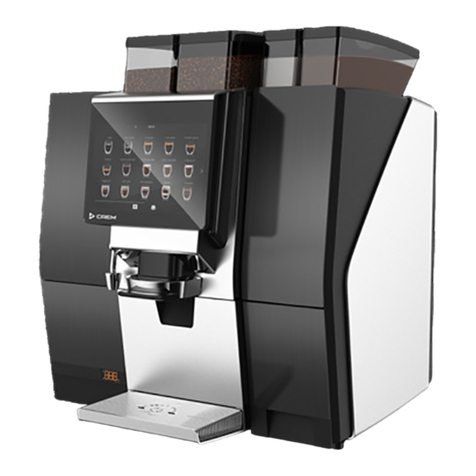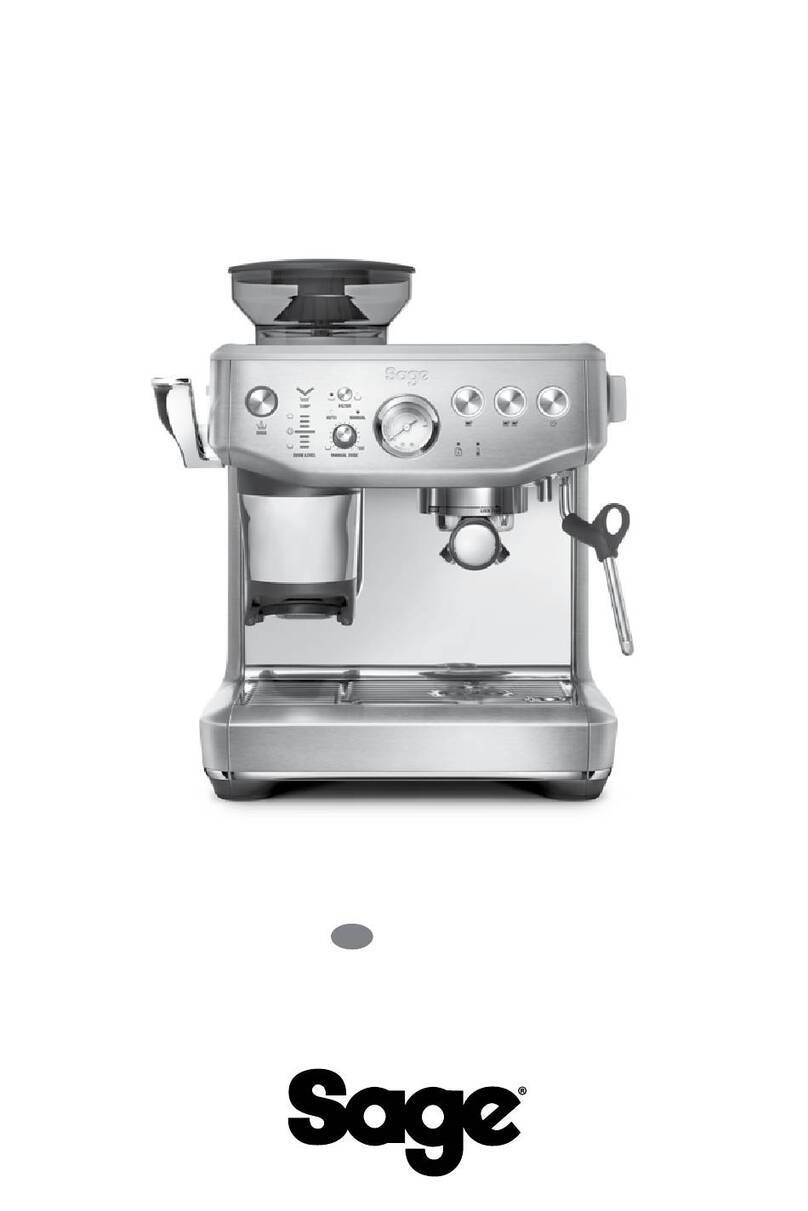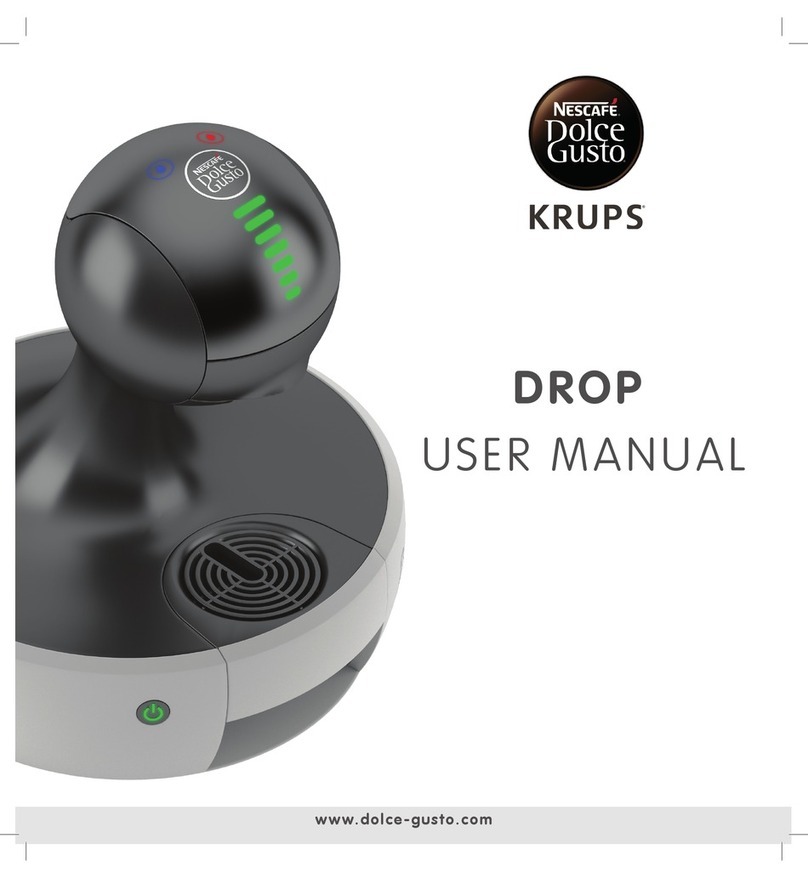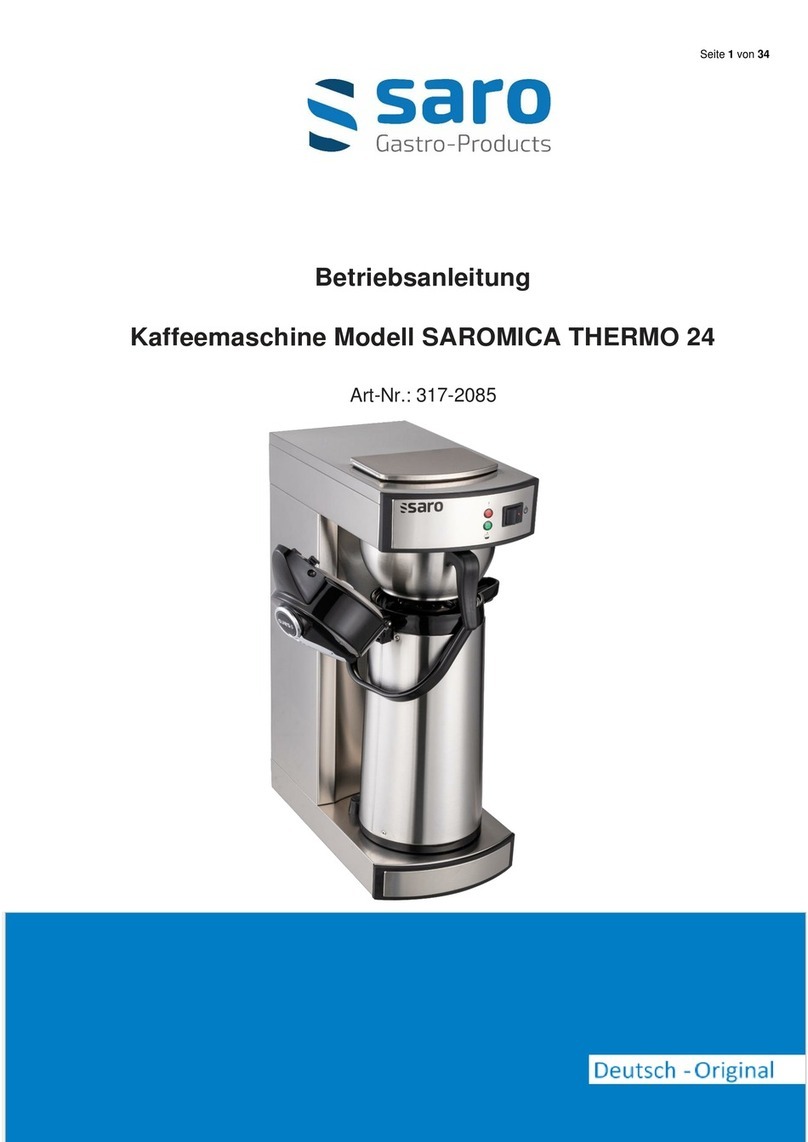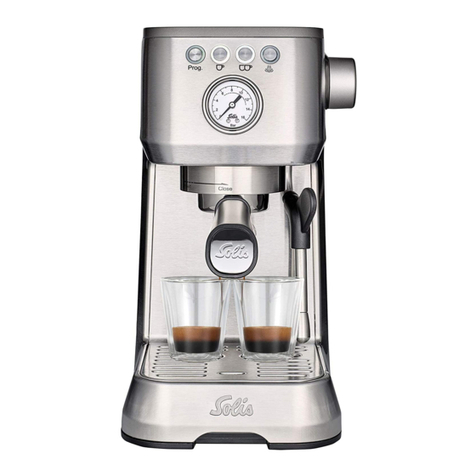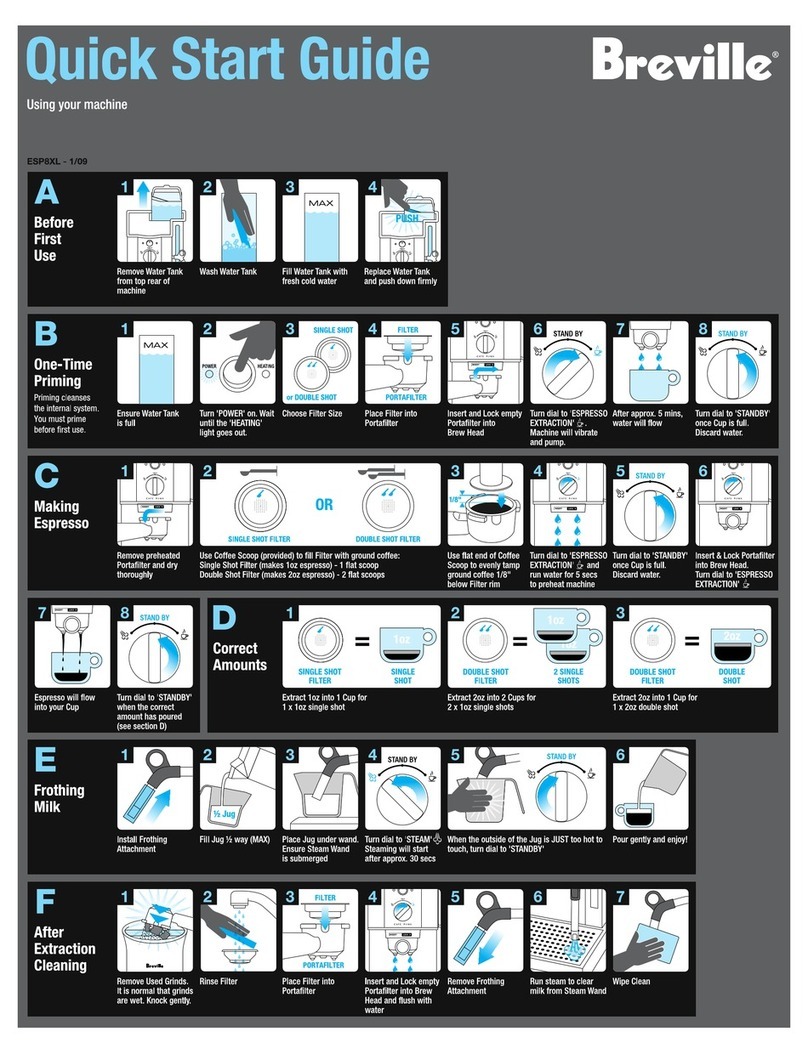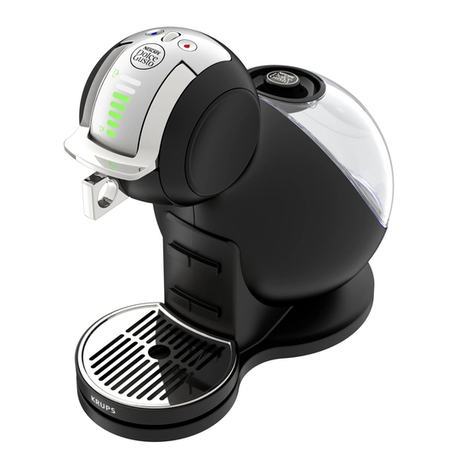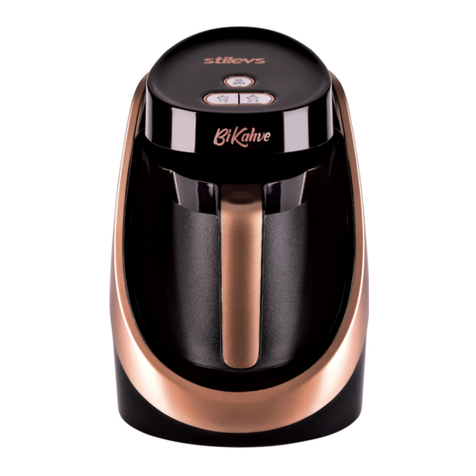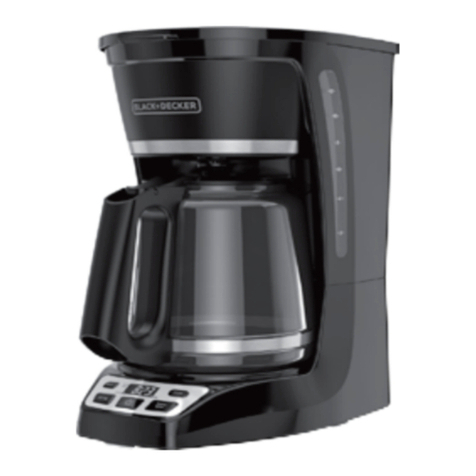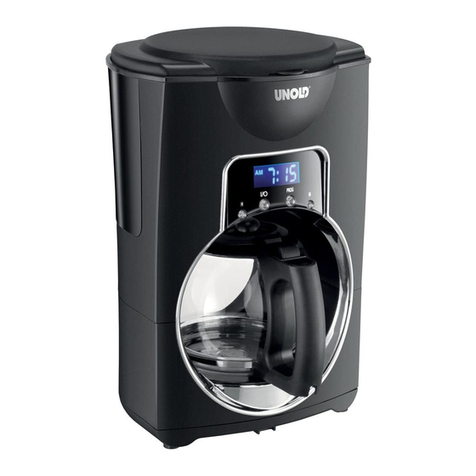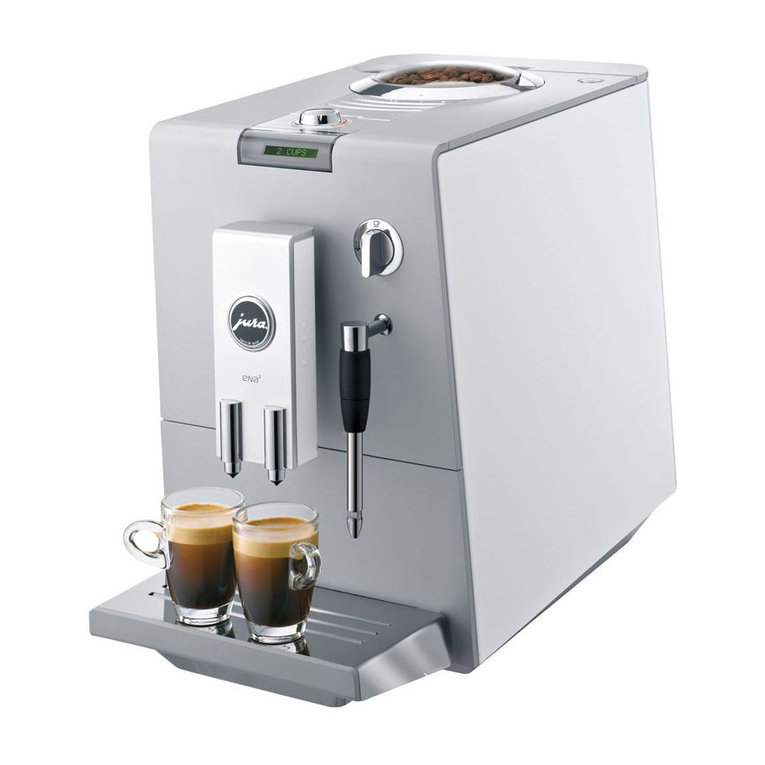Tecnosystemi Blitz 510 CL User manual

COFFEE AND CAPPUCCINO MACHINE
MAINTENANCE MANUAL
410.CL/DA.02.M
510.CL/DA.02.M
COFFEE AND CAPPUCCINO
CLASSIC VERSION &
AUTOMATIC DOSING
DA VERSION
CL VERSION

2
MAINTENANCE MANUAL
NOTICE:
This maintenance manual is a full and essential part of the product.
Read the user safety and maintenance notices carefully.
This machine must be used only for the purpose for which it was expressly designed. Any other use must be
considered improper and hence dangerous.
The manufacturer will not be liable for any damage due to improper, wrong or unreasonable use.
Tecnosystem holds itself responsible for the machine in its original configuration.
Any intervention which alters the structure or the working cycle of the machine must be carried out or
authorised by the Technical Office of Tecnosystem.
Tecnosystem does not hold itself liable for the consequences due to use of any non original spare parts.
The Company reserves the right to carry out any technical modifications to this manual and to the machine
without being obliged to give advance notice.
The property of this manual is reserved by the owner – Reproduction forbidden. The Company will safeguard
its rights to the drawings and catalogues according to the law.
Further copies of this manual may be requested from the Tecnosystem After-sales Service.
WARNINGS:
This manual is supplied with the machine and must be kept with the utmost care. Therefore it should be read
carefully in order to become familiar with the safety procedures required for servicing and operating the
machine.
This machine must be used only for the tasks it was designed for. Use of the machine for tasks other than
those specified here in is hazardous.
The Manufacturer shall not be held responsible for damage caused by improper and erroneous usage.
The Manufacturer shall be held responsible only for the machine as it was at the time of delivery.
Any modification to its construction and work-cycle must be performed or authorized by Tecnosystem
Engineering Dept.
The Manufacturer shall not be held responsible for troubles due to the use of non-original spare parts.
The Manufacturer reserves the right to make any modifications to the specifications contained in this manual
without giving prior notice.
This manual and related drawings are property of Tecnosystem, therefore they must not be reproduced in
any form.
Faillure to do so will entitle the Manufacturer to take legal action.
Additional copies of this manual are available from the TECNOSYSTEM’s After Sales Service Dept.

3
TROUBLESHOOTING:
1 – Possible problems during installation
1.1 – Pump loading manual phase relation.
2 – Possible problems due to failure to provide maintenance
2.1 - Pod holder setting (Only for model 510)
2.2 – Filter cleaning (Only for model 510)
2.3 – Maintenance of the cappuccino maker
3 – Possible problems due to electro-mechanical faults
3.1 - The machine does not turn on.
3.2 - The machine turns on but does not heat.
3.3 - When you press the coffee switch, the pump goes on in a very noisy
way, but no coffee comes out of the pipe.
3.4 - When you press the coffee switch, the pump goes on but no coffee
comes out of its spout and water comes out of the hot water pipe.
3.5 - When you press the water delivery button, the pump goes on, but the
water exits through the by-pass instead of coming out from the relevant pipe,
and goes into the tank (short pipe).
3.6 - When you press the coffee delivery button, the pump goes on but does
not let any coffee out from the relevant pipe.
3.7 - During the steam boiler water level renewal phase, the pump goes on
working for a maximum time of 2 minutes, leading to safety stopping of the
machine.
3.8 - Continuous dripping from the coffee spout when the machine is on,
even when it is not working.
3.9 – When you press the water or coffee switch, the pump is not turned
on.
3.9A - The machine makes the automatic differential switch intervene in
order to protect the power line it is connected to.
3.10 - Steam boiler pressure fault.
3.11 - The steam boiler does not heat.
3.12 - Fault with steam output during working phase.
3.13 - Faulty water output from the safety valve of the boiler during
coffee delivery phase.
3.14 – If steam delivery is requested, the pressure switch shows zero
pressure and the steam delivery stops immediately.
4 - Problems, diagnostics and instructions about the station, the
keyboard and the dosing of the DA model.
4.1 - When turning the machine on, the leds on the keyboard stay off, without
performing the turning on/off sequence.
4.2A - When selecting a coffee (high or low coffee level), a quantity of coffee
different from the preset one is obtained.

4
4.2B- When selecting a coffee (high or low coffee level) the delivery does not
stop unless the C/S button is manually pressed.
5 – Troubleshooting diagram
6 – Description of probable faults not listed in the manual

5
1 – Possible problems during installation.
1.1 – Pump loading manual phase relation.
If the machine is left without working for a long time, the soft rubber (made of food grade
silicone) may stay stuck in its seat.
To solve this problem, first fill the tank as shown in the manual, put the plug into the power
socket, press the main switch (1) (see fig. 1), press the button (4) to make sure that it is
impossible to load the pump, then try a manual operation as follows:
fig.1
1 – Lift the top lid of the device (see fig. 2).
fig.2
2 – Take the suction pipe out of the tank and inject water into the suction pipe, also using a syringe, while
keeping the button (4) pressed (see fig.3)
fig.3
3 – If you are unable to release the pump, you must replace it.

6
2 - Possible problems due to failure to provide maintenance
2.1 - Pod holder setting (Only for model 510)
Using the machine normally leads to wear of the sealing washers in the closure of the pod
holder unit. This leads to coffee coming out from the side when it is delivered.
To restore the sealing of the lining, proceed as follows:
1 – Lift the side command lever of the pod holder unit so you
can introduce the 2.5 mm Allen wrench into the screw
fastening seat (12A)(see fig.4).
fig.4
2 – Loosen the screw.
3 – Turn the hexagonal adjusting ring nut clockwise (12) in
order to close the unit tighter, or counterclockwise in order to
make the closing looser.
4 – Again carry out some closing tests using the side lever
and deliver some coffee in order to make sure that it is
properly adjusted and that the washer seals.
5 – Tighten the fastening screw again
This adjustment can be carried out several times.
When the O-Ring liner becomes too flat or is worn out, replace it as shown on figure 5a-
5b.
fig.5A fig.5B

7
2.2 – Filter cleaning (Only for model 510)
When you press the coffee switch (2) the pump goes on, but then
weakens without letting the coffee out, or letting it out very slowly (see
fig. 6).
fig.6
Possible reasons:
a) The single-dose pod contains too finely ground coffee, or the pod is
excessively filled or pressed.
b) The bottom or top coffee showers are clogged up.
Operations:
a) Check the proper grinding and dosing of the pod.
b) Clean or replace the clogged shower (see fig. 7 and 8).
– Replace the bottom shower (see fig.7)
fig.7 fig.8
– Replace the top shower (see fig. 8).

8
2.3 – Maintenance of the cappuccino maker
For the cappuccino maker to work properly, the following are needed:
a – right pressure in the steam boiler
b – careful cleaning and maintenance of the cappuccino maker
The right pressure for proper operation should be within the range between
0.8 and 1.4 Bar.
Higher or lower pressure could lead to a fault on the cappuccino maker.
Maintenance of the cappuccino maker requires keeping the inside holes
clean.
Therefore when you expect the machine to stay some time without being
used, it is good practice, after delivering a cappuccino, to wash the
cappuccino maker, sucking up water from the tank or from an outside
container.
For more accurate cleaning from time to time, take the
cappuccino maker out of its seat (see fig.9) and clean the
holes, using a tip with a smaller diameter than the holes
themselves.
fig.9
Once you have carried out this operation, when
reassembling the machine, make sure that the cappuccino
maker is fitted well in place at the end of its stroke.
In case of any persistent fault, also make sure that the pressure is high enough, or not too
high, in the steam boiler.

9
3 - Possible problems due to electro-mechanical faults
3.1 – The machine does not turn on
Reason:
a- Machine not connected to the power mains
b – Switch off
c – Other reasons: See final summary page on “Troubleshooting”.
3.2 – The machine turns on but does not heat.
Reason:
a – No water in the tank
b – Other reasons: Thermostat, Resistance or other elements faulty
(See final summary page on “Troubleshooting”).
Operations:
a – Fill the tank
b – Replace the thermostat
c – Replace the coffee boiler resistance (see fig. 9a)
fig.9a
Operation B – Main stages:
1 – Disconnect the wires which are connected to the
thermostat.
2 – Unscrew the thermostat (see fig.10 - 11)

10
fig.10 fig.11
1 – Replace and screw back the thermostats.
2 – Connect the wires again
Operation C – Main stages:
1 – Disconnect the wires (see fig.12)
2 – Disconnect the water pipes (see fig.13)
fig.12 fig.13
3 – Unscrew the nuts from below the frames
4 – Take the boiler out and unscrew the 4 screws M5
indicated by the arrow (see fig.14).
5 – Open the boiler (see fig.15).
fig.14 fig.15
6 – Unscrew the resistance nuts (see fig.16).

11
fig.16 fig.17
7 – Take out the resistance (see fig.17).
8 – Fit in the new resistance with the 2 new O-ring washers.
9 – Reassemble the whole unit carrying out the operations in
reverse order.

12
3.3 – When you press the coffee switch (2)(fig.18), the pump goes
on in a very noisy way, but no coffee comes out of the pipe (11).
fig.18
Reason:
Pump empty due to lack of water in the tank or to emptying or to an air
bubble in the pump suction pipe.
Operation:
a – Make sure there is water in the tank.
b – Load the pump, pressing only the water button (4).

13
3.4 - When you press the coffee switch (2), the pump goes on but
no coffee comes out of the spout (11) and water comes out of the
hot water pipe (9) (see fig. 19 and 20).
fig.19 fig.20
Possible reasons:
The solenoid valve (e1) may be dirty or faulty, and therefore stays locked in
its open position (see fig. 20).
Operations:
Clean or replace the solenoid valve (e1) as shown on figures 21 and 22.
1 – Unscrew the nut.
2 - Take out the spool (see fig.21)
fig.21 fig.22
3 – Unscrew the steel sleeve (see fig.22).
4 – Take out the inside cylinder to see whether it needs to
be cleaned, for example from calcium residue.
5 – Unscrew the brass base in order to replace the whole
solenoid valve if necessary.
6 – Reassemble the whole unit carrying out the operations in
reverse order.

14
3.5 - When you press the water delivery button (4) (see fig. 23), the
pump goes on but the water exits through the by-pass (c1), instead
of coming out from the relevant pipe (9), and goes into the tank
(short pipe).
Reason:
The solenoid valve (e1) is faulty, so it stays locked in a closed position (see
fig.24).
fig.23 fig.24
Operations:
a – Replace the solenoid valve spool.
b – Clean the inside of the solenoid valve sleeve (see fig.25-26)
c – Replace the solenoid valve.
Operation B – Main stages:
1 – Unscrew the nut.
2 - Take out the spool (see fig.25)
fig.25 fig.26
3 – Unscrew the steel sleeve c1 (see fig.26).
4 – Take out the inside cylinder to see whether it needs to
be cleaned, for example from calcium residue.
5 – Unscrew the brass base in order to replace the whole
solenoid valve if necessary.
6 – Reassemble the whole unit carrying out the operations in
reverse order.

15
3.6 – When you press the coffee delivery button (2), see fig. 27, the
pump goes on, but no coffee is delivered from the relevant pipe
(11).
fig.27
Note
The water could exit through:
a - the by-pass (c1), into the tank (short pipe)(fig.27a);
b - the solenoid valve e3, locked in the open position, into the steam boiler.
Possible reasons:
a – The coffee solenoid valve (e2) stays locked in the closed position.
b – The solenoid valve (e3) stays in its locked open position, and water flows
out into the steam tank. Important! : Failure to recognize this problem
leads to total filling of the steam boiler and then to water coming out of
the steam safety valve.
c – Electronic station faulty (Valid only for the DA models).
Operations:
a-b - Clean the solenoid valve if dirty, or replace it if faulty (e2 or e3) (see fig.
27a).
1 – Replace the station (see paragraph 3.11 fig. 37).
fig.27a

16
3.7 – During the steam boiler water level renewal phase, the pump
goes on working for a maximum time of 2 minutes, leading to
safety stopping of the machine.
Possible reasons:
The solenoid valve (e3) stays in its locked closed position and the water,
instead of flowing into the steam boiler, overcomes the restriction of the by
pass (c1) and flows into the water tank.
Operations:
Clean the solenoid valve (e3) if dirty, or replace it if faulty (see fig.28).
fig.28

17
3.8 – Continuous dripping from the coffee spout when the machine
is on, even when it is not working.
Possible reasons:
a – The solenoid valve (e2) is dirty or faulty and stays in open locked position
(fig.28).
b – Inside injector of the boiler is broken or lacks sealant on its threaded
ends.
Operations:
a – Clean or replace the solenoid valve e2.
b – Replace the injector.
Operation a:
See fig.25 – 26 page 13
Operation b – Main stages:
(Valid up to: 04/06 Serial number: 060274)
Replace the injector T1 (see fig.28a).
fig.28a
Remove the curve T2 (see fig.28b) NOTE While unscrewing the blocking nut of the curve, it is
important to keep blocked, with a second key, the underplaced hexagon coupling R1.
Unscrew the hexagon coupling R1 (see fig.28c)
fig.28b fig.28c
At this point, one of the following situations may take place:
The pipe comes out together with the coupling (see
fig. 28d)
The pipe stays fitted inside the boiler (see fig.28e)

18
fig.28d fig.28e
If the pipe stays fitted inside the boiler, you can make the following attempt:
fig.30 Try to unscrew the pipe using pliers(fig.30).
If the pipe comes out unbroken, replace it as follows:
- Empty the boiler (to make this operation easier,
remove the bottom shower of the boiler).
- Replace the pipe. Make sure that you put the
sealant properly on the new pipe: first on the
threaded part screwed into the bottom of the boiler
and then on the top threaded part before screwing
back on the hexagon coupling R1 (see fig. 28e).
If you are unable to take out the pipe, or if the pipe
breaks and the threaded bottom part stays screwed
on inside the boiler, you must open the boiler as
follows.
- Disconnect the boiler wires
- Disconnect the water pipes
- Unscrew the nuts from below the frames
- Take out the boiler
- Unscrew the 4 screws M5 (see fig. 31)
fig.31

19
- Open the boiler (see fig. 32).
- Remove the injector (see fig. 33)
- Replace the pipe
fig.32 fig.33
- Reassemble the unit proceeding in the reverse order. Make sure that you put the sealant properly on the
new injector: first on the threaded part screwed into the bottom of the boiler and then – after the boiler has
been reassembled - on the top threaded part before screwing back on the hexagon coupling (see fig.30).
NOTE While screwing back the blocking nut of the curve, it is important to keep blocked, with a
second key, the underplaced hexagon coupling R1 (see fig. 28c).
Operation b – Main stages:
(Version produced since:11/04/06 Serial number: 060275)
Replace the injector T1 (see fig.28a).
fig.28a

20
fig.28b fig.28c
Remove the curve T2 (see fig.28b) Unscrew the hexagonal manifold R1 (see fig. 28c)
fig.28d fig.28e
Take the manifold out of the boiler (see fig. 28d) Replace the 2 OR 2018 (see fig. 28e)
fig.28f
NOTE
Reassemble all parts, proceeding in the reverse order (see fig. 28f) and put the sealant on the 1/8” coupling
thread. You are recommended to slightly lubricate the 2 ORs using a non-toxic fat.
This manual suits for next models
3
Table of contents


